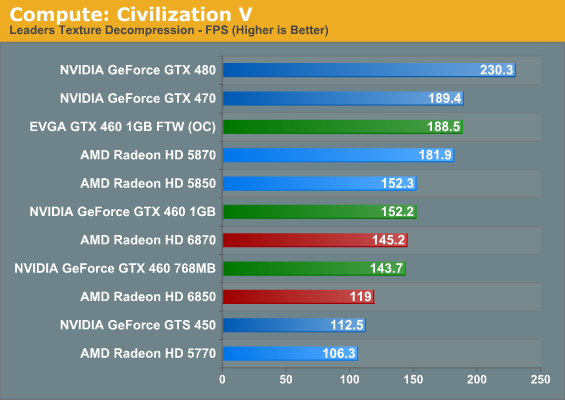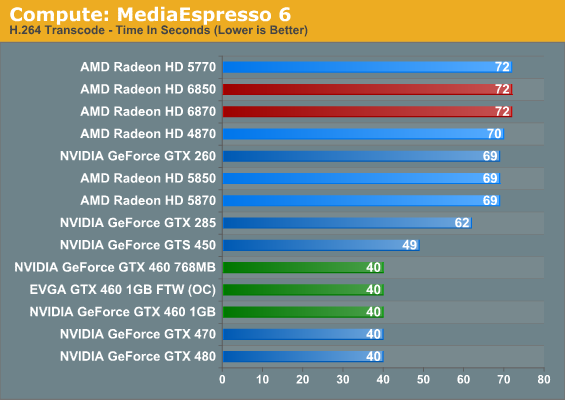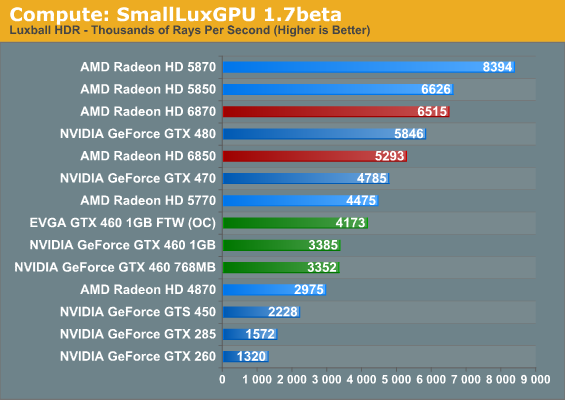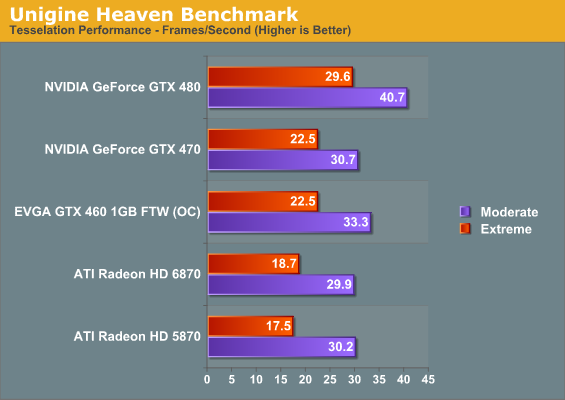AMD’s Radeon HD 6870 & 6850: Renewing Competition in the Mid-Range Market
by Ryan Smith on October 21, 2010 10:08 PM ESTFor a while now we’ve been trying to establish a proper cross-platform compute benchmark suite to add to our GPU articles. It’s not been entirely successful.
While GPUs have been compute capable in some form since 2006 with the launch of G80, and AMD significantly improved their compute capabilities in 2009 with Cypress, the software has been slow to catch on. From gatherings such as NVIDIA’s GTC we’ve seen first-hand how GPU computing is being used in the high-performance computing market, but the consumer side hasn’t materialized as quickly as the right situations for using GPU computing aren’t as straightforward and many developers are unwilling to attach themselves to a single platform in the process.
2009 saw the ratification of OpenCL 1.0 and the launch of DirectCompute, and while the launch of these cross-platform APIs removed some of the roadblocks, we heard as recently as last month from Adobe and others that there’s still work to be done before companies can confidently deploy GPU compute accelerated software. The immaturity of OpenCL drivers was cited as one cause, however there’s also the fact that a lot of computers simply don’t have a suitable compute-capable GPU – it’s Intel that’s the world’s biggest GPU vendor after all.
So here in the fall of 2010 our search for a wide variety of GPU compute applications hasn’t panned out quite like we expected it too. Widespread adoption of GPU computing in consumer applications is still around the corner, so for the time being we have to get creative.
With that in mind we’ve gone ahead and cooked up a new GPU compute benchmark suite based on the software available to us. On the consumer side we have the latest version of Cyberlink’s MediaEspresso video encoding suite and an interesting sub-benchmark from Civilization V. On the professional side we have SmallLuxGPU, an OpenCL based ray tracer. We don’t expect this to be the be all and end all of GPU computing benchmarks, but it gives us a place to start and allows us to cover both cross-platform APIs and NVIDIA & AMD’s platform-specific APIs.
Our first compute benchmark comes from Civilization V, which uses DirectCompute to decompress textures on the fly. Civ V includes a sub-benchmark that exclusively tests the speed of their texture decompression algorithm by repeatedly decompressing the textures required for one of the game’s leader scenes.

In our look at Civ V’s performance as a game, we noted that it favors NVIDIA’s GPUs at the moment, and this may be part of the reason why. NVIDIA’s GPUs clean up here, particularly when compared to the 6800 series and its reduced shader count. Furthermore within the GPU families the results are very straightforward, with the order following the relative compute power of each GPU. To be fair to AMD they made a conscious decision to not chase GPU computing performance with the 6800 series, but as a result it fares poorly here.
Our second compute benchmark is Cyberlink’s MediaEspresso 6, the latest version of their GPU-accelerated video encoding suite. MediaEspresso 6 doesn’t currently utilize a common API, and instead has codepaths for both AMD’s APP (née Stream) and NVIDIA’s CUDA APIs, which gives us a chance to test each API with a common program bridging them. As we’ll see this doesn’t necessarily mean that MediaEspresso behaves similarly on both AMD and NVIDIA GPUs, but for MediaEspresso users it is what it is.

We decided to go ahead and use MediaEspresso in this article not knowing what we’d find, and it turns out the results were both more and less than we were expecting at the same time. While our charts don’t show it, video transcoding isn’t all that GPU intensive with MediaEspresso; once we achieve a certain threshold of compute performance on a GPU – such as a GTX 460 in the case of an NVIDIA card – the rest of the process is CPU bottlenecked. As a result all of our Fermi NVIDIA cards at the GTX 460 or better take just as long to encode our sample video, and while the AMD cards show some stratification, it’s on the order of only a couple of seconds. From this it’s clear that with Cyberlink’s technology having a GPU is going to help, but it can’t completely offload what’s historically been a CPU-intensive activity.
As for an AMD/NVIDIA cross comparison, the results are straightforward but not particularly enlightening. It turns out that MediaEspresso 6 is significantly faster on NVIDIA GPUs than it is on AMD GPUs, but since we’ve already established that MediaEspresso 6 is CPU limited when using these powerful GPUs, it doesn’t say anything about the hardware. AMD and NVIDIA both provide common GPU video encoding frameworks for their products that Cyberlink taps in to, and it’s here where we believe the difference lies.
In particular we see MediaEspresso 6 achieve 50% CPU utilization (4 core) when being used with an NVIDIA GPU, while it only achieves 13% CPU utilization (1 core) with an AMD GPU. At this point it would appear that the CPU portions of NVIDIA’s GPU encoding framework are multithreaded while AMD’s framework is singlethreaded. And since the performance bottleneck for video encoding still lies with the CPU, this would be why the NVIDIA GPUs do so much better than the AMD GPUs in this benchmark.
Our final GPU compute benchmark is SmallLuxGPU, the GPU ray tracing branch of the open source LuxRender renderer. While it’s still in beta, SmallLuxGPU recently hit a milestone by implementing a complete ray tracing engine in OpenCL, allowing them to fully offload the process to the GPU. It’s this ray tracing engine we’re testing.

Compared to our other two GPU computing benchmarks, SmallLuxGPU follows the theoretical performance of our GPUs much more closely. As a result our Radeon GPUs with their difficult-to-utilize VLIW5 design end up topping the charts by a significant margin, while the fastest comparable NVIDIA GPU is still 10% slower than the 6850. Ultimately what we’re looking at is what amounts to the best-case scenarios for these GPUs, with this being as good an example as any that in the right circumstances AMD’s VLIW5 shader design can go toe-to-toe with NVIDIA’s compute-focused design and still win.
At the other end of the spectrum from GPU computing performance is GPU tessellation performance, used exclusively for graphical purposes. For the Radeon 6800 series, AMD enhanced their tessellation unit to offer better tessellation performance at lower tessellation factors. In order to analyze the performance of AMD’s enhanced tessellator, we’re using the Unigine Heaven benchmark and Microsoft’s DirectX 11 Detail Tessellation sample program to measure the tessellation performance of a few of our cards.

Since Heaven is a synthetic benchmark at the moment (the DX11 engine isn’t currently used in any games) we’re less concerned with performance relative to NVIDIA’s cards and more concerned with performance relative to the 5870. Compared to the 5870 the 6870 ends up being slightly slower when using moderate amounts of tessellation, while it pulls ahead when using extreme amounts of tessellation. Considering that the 6870 is around 7% slower in games than the 5870 this is actually quite an accomplishment for Barts, and one that we can easily trace back to AMD’s tessellator improvements.

Our second tessellation test is Microsoft’s DirectX 11 Detail Tessellation sample program, which is a much more straightforward test of tessellation performance. Here we’re simply looking at the framerate of the program at different tessellation levels, specifically level 7 (the default level) and level 11 (the maximum level). Here AMD’s tessellation improvements become even more apparent, with the 6870 handily beating the 5870. In fact our results are very close to AMD’s own internal results – at level 7 the 6870 is 43% faster than the 5870, while at level 11 that improvement drops to 29% as the increased level leads to an increasingly large tessellation factor. However this also highlights the fact that AMD’s tessellation performance still collapses at high factors compared to NVIDIA’s GPUs, making it all the more important for AMD to encourage developers to use more reasonable tessellation factors.










197 Comments
View All Comments
Ryan Smith - Friday, October 22, 2010 - link
Quality is unchanged. UVD 3 adds a few fixed function blocks, but quality is a matter of post-processing and hence affected by the drivers once you have sufficient shader power to do all the post-processing.Pastuch - Friday, October 22, 2010 - link
I posted about this earlier but my post was deleted.Ryan there is a ton of HTPC users on this site.
1. Exactly how long is the Radeon 6870/6850 vs the GTX 460?
2. How does the GTX460 compare to the Radeon 6 series regarding bitstreaming high def audio?
3. How UVD3 post-processing compare to Nvidias?
Ryan Smith - Friday, October 22, 2010 - link
It's exactly the same as this: http://www.anandtech.com/show/3973/nvidias-geforce...HigherGround - Friday, October 22, 2010 - link
Why was EVGA card included in this test? The rest of the field is generic (non OC, no brand), so why included an OC card, which skews the readers perspective? Pretty sure EVGA paid you to included its top OC card in this review ...Parhel - Friday, October 22, 2010 - link
No, NVidia paid them to include it. NVidia sends "guidelines" to all the hardware review sites, telling them what settings to use and which cards to use in the comparison. In the guidelines for today's review was to use the EVGA GTX 460 FTW, and and site you see using it is essentially a paid NVidia shill.I could care less about ATI vs NVidia, as I'm not really a gamer, but I'm very disappointed today to see my long time favorite hardware site stooping to this level. In the end, it gives consumers bad information, which should be antithetical to the purpose of a site like this.
AtwaterFS - Friday, October 22, 2010 - link
I agree, this site is typically class-leading, but this article give AnandTech a bit of a black eye and the results dont particularly jive with "un-biased" sites like HardOCP.DrKlahn - Friday, October 22, 2010 - link
I was going to post the same thing. As a long time reader of this site, I was very disappointed with the decision to include the overclocked card. Either the ATI cards should have been overclocked and their results provided in every test or it should have been excluded as per the normal benchmarking guidelines.I would have no issue with a followup or side article comparing factory overclocked offerings. But this is clearly bowing to pressure from Nvidia and I expected better of this site.
aungee - Saturday, October 23, 2010 - link
To Include the EVGA GTX 460 FTW was unfair and whether intentional or not it did spoil the launch party for AMD on this site to some degree. It would have been more appropriate to make a small mention of it's existence and to benchmark it in the future against any factory OC 6800 cards.After getting your head around the naming, AMD needs to be credited for bringing such a performance on only a 255 mm2 package (it even caused the price drop for the 530mm2 GTX 470) . AMD has headroom to drop the price of the 6800 cards so lets hope they do soon.
tigersty1e - Friday, October 22, 2010 - link
I couldn't find the clocks, but if you do include an OC'd card in your benches, you should give us the clocks.dertechie - Friday, October 22, 2010 - link
850 MHz Core, 1700 MHz shaders, 4 GHz Memory, up from 675 MHz Core, 1350 MHz shaders, 3.6 GHz Memory.That's a 26% Core OC and an 11% Memory OC. However, the cost has been OC'd too, the FTW card costs the same $240 as the stock Radeon 6870.